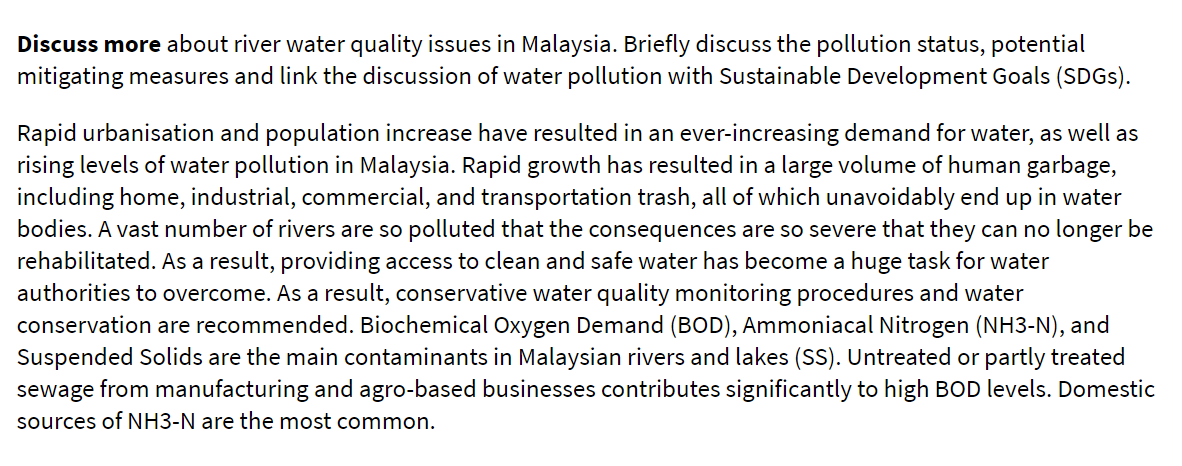Discuss more about river water quality issues in Malaysia. Briefly discuss the pollution status, potential mitigating measures and link the discussion of water pollution with Sustainable Development Goals (SDGS).
Discuss more about river water quality issues in Malaysia. Briefly discuss the pollution status, potential mitigating measures and link the discussion of water pollution with Sustainable Development Goals (SDGS).
Applications and Investigations in Earth Science (9th Edition)
9th Edition
ISBN:9780134746241
Author:Edward J. Tarbuck, Frederick K. Lutgens, Dennis G. Tasa
Publisher:Edward J. Tarbuck, Frederick K. Lutgens, Dennis G. Tasa
Chapter1: The Study Of Minerals
Section: Chapter Questions
Problem 1LR
Related questions
Question
100%

Transcribed Image Text:Discuss more about river water quality issues in Malaysia. Briefly discuss the pollution status, potential
mitigating measures and link the discussion of water pollution with Sustainable Development Goals (SDGS).
Rapid urbanisation and population increase have resulted in an ever-increasing demand for water, as well as
rising levels of water pollution in Malaysia. Rapid growth has resulted in a large volume of human garbage,
including home, industrial, commercial, and transportation trash, all of which unavoidably end up in water
bodies. A vast number of rivers are so polluted that the consequences are so severe that they can no longer be
rehabilitated. As a result, providing access to clean and safe water has become a huge task for water
authorities to overcome. As a result, conservative water quality monitoring procedures and water
conservation are recommended. Biochemical Oxygen Demand (BOD), Ammoniacal Nitrogen (NH3-N), and
Suspended Solids are the main contaminants in Malaysian rivers and lakes (SS). Untreated or partly treated
sewage from manufacturing and agro-based businesses contributes significantly to high BOD levels. Domestic
sources of NH3-N are the most common.
Expert Solution
This question has been solved!
Explore an expertly crafted, step-by-step solution for a thorough understanding of key concepts.
Step by step
Solved in 2 steps

Recommended textbooks for you

Applications and Investigations in Earth Science …
Earth Science
ISBN:
9780134746241
Author:
Edward J. Tarbuck, Frederick K. Lutgens, Dennis G. Tasa
Publisher:
PEARSON

Exercises for Weather & Climate (9th Edition)
Earth Science
ISBN:
9780134041360
Author:
Greg Carbone
Publisher:
PEARSON

Environmental Science
Earth Science
ISBN:
9781260153125
Author:
William P Cunningham Prof., Mary Ann Cunningham Professor
Publisher:
McGraw-Hill Education

Applications and Investigations in Earth Science …
Earth Science
ISBN:
9780134746241
Author:
Edward J. Tarbuck, Frederick K. Lutgens, Dennis G. Tasa
Publisher:
PEARSON

Exercises for Weather & Climate (9th Edition)
Earth Science
ISBN:
9780134041360
Author:
Greg Carbone
Publisher:
PEARSON

Environmental Science
Earth Science
ISBN:
9781260153125
Author:
William P Cunningham Prof., Mary Ann Cunningham Professor
Publisher:
McGraw-Hill Education

Earth Science (15th Edition)
Earth Science
ISBN:
9780134543536
Author:
Edward J. Tarbuck, Frederick K. Lutgens, Dennis G. Tasa
Publisher:
PEARSON

Environmental Science (MindTap Course List)
Earth Science
ISBN:
9781337569613
Author:
G. Tyler Miller, Scott Spoolman
Publisher:
Cengage Learning

Physical Geology
Earth Science
ISBN:
9781259916823
Author:
Plummer, Charles C., CARLSON, Diane H., Hammersley, Lisa
Publisher:
Mcgraw-hill Education,